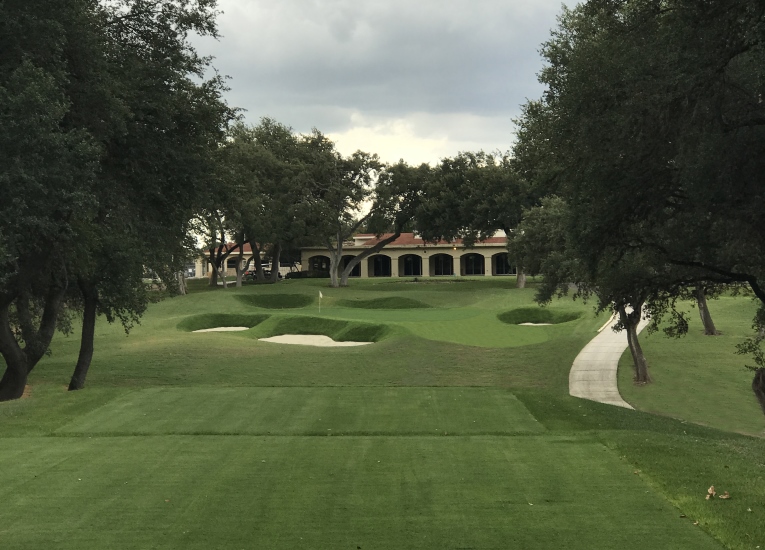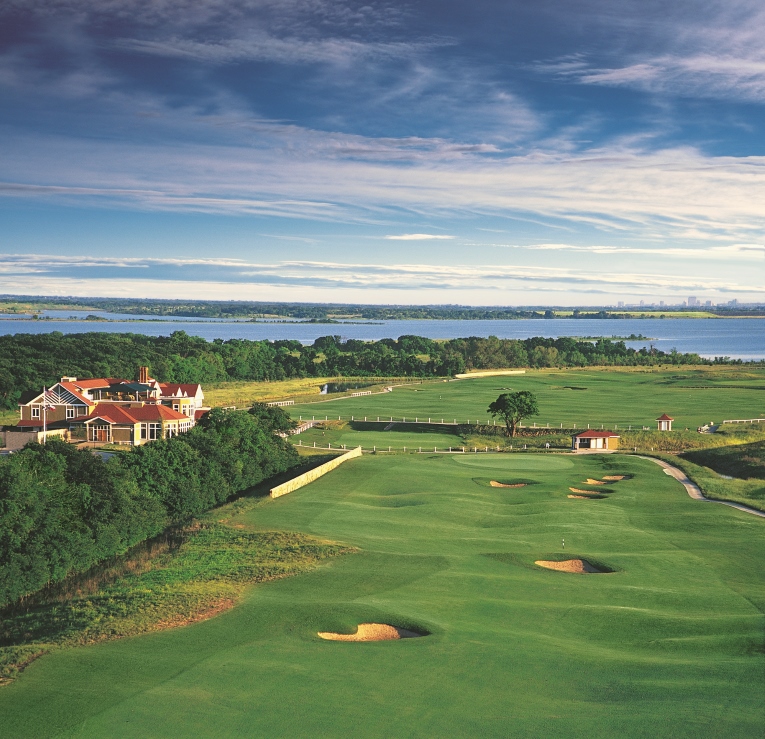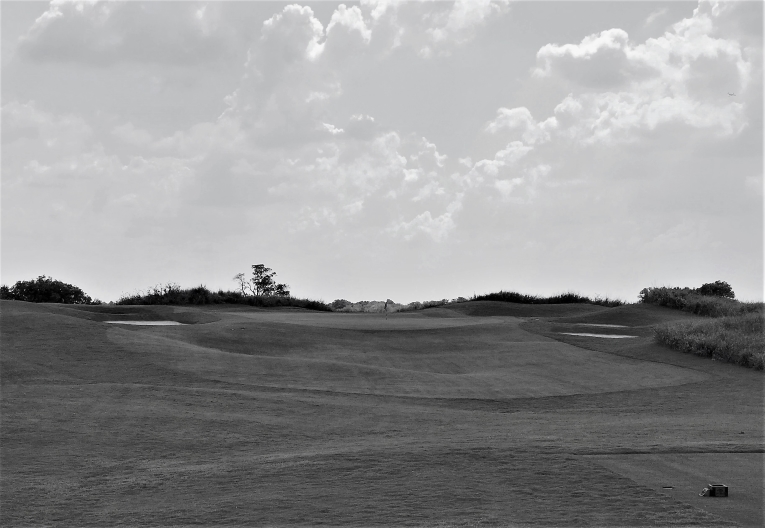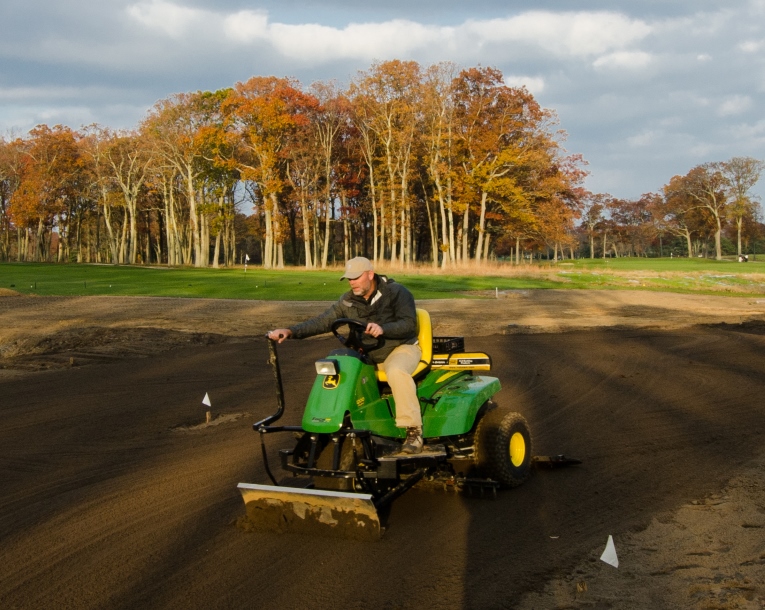Feature Interview with Tripp Davis
September, 2018
Tripp Davis is a member of the American Society of Golf Course Architects and is the principal, Lead Golf Course Architect, of Tripp Davis and Associates.
1. How did you get into architecture?
I grew up playing courses in tournaments in Atlanta and around the South designed by some of the best early architects, and the design of the courses fascinated me. At first, it was mostly about studying the design to play the courses better, but it evolved into a fascination of the design itself. When I was 15 the Atlanta paper did an article about me after being named an AJGA All-American and when asked about where I wanted to go in the game, I said I really wanted to be a golf course architect. It was a dream my family supported that I never gave up on. After I was as NCAA All-American in 1989 my last year on the Oklahoma golf team I thought I could play, so I tried to play professionally for about a year and a half. I injured my shoulder and it was a blessing in that I realized I really love to play the game, but not so much for a living. I went back to the University of Oklahoma and completed my Masters in Landscape Architecture. I had a chance to go work for a big name firm, while I also had a chance right out of school to design two 9 hole projects for the State of Oklahoma through some contacts I made playing at OU. I chose to do the Oklahoma projects and start my own company in 1994. I did not know much beyond how the game is played strategically, but learning on my own may have been another blessing. It lengthened my learning curve, but the lessons were harder learned, and it may have been better for me to learn that way. I am lucky my family today still supports my dream.
2. Who or what (books/specific courses) have been your greatest influence?
Playing in and around Oklahoma in college you cannot escape the influence of Perry Maxwell. The OU course I played then was still very much an original Maxwell. His lay of the land routings and greens still impact me. Reading articles by Ron Whitten and Brad Klein, some of the old books like the Spirit of St Andrews, and books by Geoff Shackelford, were inspiring as much as anything. They encouraged me to think outside the box and expand my knowledge of the game into how style is important.
The most impactful courses on me have been Prairie Dunes, Winged Foot, Pine Valley, and in the modern era courses I have taken a lot from are Sand Hills, Oak Tree and LACC North. They are all different stylistically, but the way style and strategy are blended together is again inspiring. I do not think I have adopted any sort of style from what I have seen, but I have tried to be varied, which is important when doing work on architecturally significant courses where I think it is important to try to mimic details in style that were original or that you can take from examples of the original golf architect – it is a part of the historic legacy of that course.
3. You have been an architect for over 20 years. A lot of great courses have been built in that time while simultaneously, new course construction took a real blow in 2007 and is still recovering. What has it been like to be an architect during a period of such creative highs and lows?
I was fortunate that we had two good projects that went forward in 2008 in our rebuild of Preston Trail in Dallas, where we had no real constraints, and the renovation/”restoration” work we did with everyone at Oak Tree in Oklahoma, where their objective was getting it ready for another major tournament – it ended up hosting the 2014 US Senior Open. I was also fortunate that our new courses at Old American in Dallas that opened in 2010, the Fairmont Course in Acapulco named Turtle Dunes that opened in early 2012, and our new course in China named Eco City International that opened in late 2013, were all projects we were given creative freedom with good budgets.
We also had the opportunity in 2015 to do a unique and creative new course with Tom Lehman in Ocala Florida named Ocala Preserve, which is sort of hard to explain, but it is an 18 hole par three course that has a 6 hole course intertwined with a par five, four par four holes and a par three.

The 4th at Ocala, where the bunkers were inspired by the Australian Sand Belt courses. Since the site was all sand, Tripp worked to create a fast course tee to green like in the Sand Belt.
In between and since, we have had fun work redesigning The University of Oklahoma Course to get it ready for future NCAA Regionals and hopefully an NCAA Championship.

The 2018 NCAA Regionals were held at the University of Oklahoma Course this spring. Above is the 17th hole.
We have had a chance to work on a few different Tillinghast courses, most recently reworking Oak Hills in San Antonio.
We just finished a complete rebuild of the Northwood Club in Dallas that Bill Diddel designed and hosted the 1952 U.S. Open.
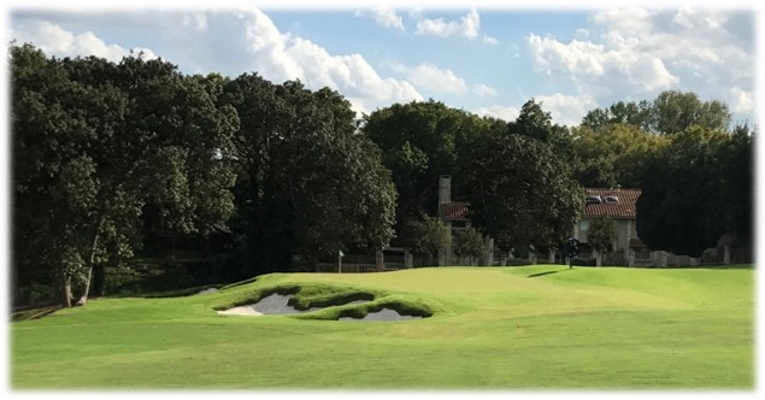
The 7th green at Northwood, where Tripp researched older Diddel courses to come up with the bunker style.
We are working on a neat project at Willow Brook in Tyler, Texas to redesign a course on a great site. We did a large bit of work at Whippoorwill near NYC, and we have worked at Rumson CC in NJ, Rolling Hills in CT, and Burning Tree in CT where we have redesigned all of the greens and bunkers. So, we have been really fortunate to not have the downturn impact what we could do creatively.
I hired Jason Gold as my on staff Shaper in 2008, which many would have thought I was crazy to do in that economic environment, but he and I, along with Kyle Downs, and the golf course builders we have worked with, have been able to freely express ourselves, learn, and continue to get better creatively. While there is a lot less new course work, that which has been done has mostly been really good and we have been able to go see those and learn, and I think there has been a lot of great renovation/”restoration” work completed that we can be inspired by as well. I know there may have been work done that was somewhat stifled creatively, but mostly I think there has been a lot of great work, which I think is a good testament to the current golf architects and those behind making the work a reality.
4. You are an ace player, having played in 15 U.S.G.A. championships. So … how do you challenge the elite golfers who can cover 500 yards with a driver/pitching wedge while simultaneously, making the hole interesting for the average club golfer who might need a driver/3 WOOD/pitching wedge to cover the same distance?
You could write an entire book on this subject, so I will try to be as brief as I can.
In the modern game, even the elite players play very different types of games. While some elite players can cover 500 yards with a driver and pitching wedge, most cannot. I think one of the most misunderstood factors of the modern game is that all elite players average over 300 yards and can pump one out there to 350 when they want. The reality is that only a minority of players can do this.
I think design and setup of golf courses too often considers length to be a superior advantage relative to precision, or good iron play from the proper angle, etc. I believe in what I call balance – design that does not favor any one type of physical skill over the course of the round that tests every part of the game as best as possible in some way. It is in testing every part of the game where you can create more balance between the longest players and the average to shorter players. One test is to require the longer player to be more precise and not be able to use their length on most every hole. Good design and setup does not value or favor any one specific strength in my opinion. It should value or favor the ability to strategically combine a variety of strengths, and strategically avoid a weakness, even if that weakness is momentary. If the design and setup of a course results in the most important skill a player has being the ability to score, or combine a variety of strengths and overcome test of one’s weaknesses to get the ball in the hole, the golf course has balance. Inherent in providing balance is providing a good many meaningful options, or options that players will actually use, which is one of the keys I have found to allowing a course to be challenging to an elite or scratch player, while also being interesting and enjoyable for the average club player.
Another important factor in this pursuit is to realize that many things in design that make the game a bit easier on the average club player, such as a wider fairway in places, safe places to miss off the tee or at the green, and not using penal features to create “definition” in places, can be used to subtly challenge the better player. You may not use these all of the time to subtly challenge the better player, but using these traits in places can be effective. You have to realize that the elite or scratch player is looking to play shots with a much smaller margin for error and when a shot is really well defined, the “bullseye” is easier to see. When design moves a player’s eye away from the “bullseye,” that focus is harder to come by, it is harder to commit and execute. Players playing really well may still get that focus, but if there is any doubt, their focus can be strained. When there is a wider fairway, away from the guarded line with the best angle to the green or a hole location, their focus can be lessened. When instead of having both sides of a green guarded strictly, there is a safe miss wide of the green, or there is a larger green with a lot of room to play away from a guarded hole location, their focus can be lessened. When you provide more options to recover from around a green, the elite or scratch player can find it hard to commit and execute.
One of the most typical things I find in renovation work that can make it harder for the average club players are challenging or penal features (bunkers, trees, rough, water, slopes, visual intimidation, etc) that don’t have much or any impact on the better player, while being a strong challenge for the average player. While bunker placement and visual intimidation are the two most common, I think a course with greens mostly comprised of severe slopes may be the most egregious. The average club player is typically their weakest at putting, and/or the short shots around a green, so severe greens are really tough for them. But, for an elite or scratch player, if they are challenged to match up line and speed on and around the green, that will test their game, and you don’t need severe greens to do that. Subtle, hard to read slopes with constant subtle changes in direction of slope can be as challenging. The average club player is looking to two putt from 25 feet in reality, when the elite or scratch player is looking to make that 25 foot putt. If that 25 foot putt subtly changes directions of break, or degree of break, and the speed changes over that 25 feet, even subtly, matching line and speed is just as tough, if not tougher than on a more severe green. Mentally, the greens with a lot subtleties can have a stronger impact on a player’s confidence because they tend to see these as makeable putts, but when a green is severe, they may not expect to make a putt and when they do get a more makeable putt, and their confidence is not as impacted. I would not call the greens at Sand Hills severe for the most part – they are pretty subtle and hard to match line and speed and I have a lot of trouble on those greens – just played there last week.
The other key factor I see is designing so that changes in course setup can ratchet up the challenge for the elite or scratch players. Even though I have found that requiring an elite player to read a lie in a shorter rough can be just as challenging as taller rough, there are places where a taller rough can be more challenging, especially around a green. Getting fairways firmer can be more challenging in a few ways – when design requires some measure of distance control off the tee, when slopes can carry a bouncing ball more towards a hazard of some sort, or when slopes can lead a ball in a wider fairway to a really poor angle. Having hole locations on a green that can be used when the intent is to make the course a lot more challenging, especially by way of “requiring” the player to play at this hole location from a very specific angle is important. And most obvious may be getting the greens firmer and faster – firmer making it more important to get to a good angle of approach, and speed turning what are manageable slopes for the club member into a greater challenge for the elite or scratch player.
5. You mentioned on the phone that Pine Valley was your world #1 favorite course. That exalted position wasn’t just because you played there once and had a great time; you have played in 7 Crump Cups! We talked about the ground game and you noted the error in most ground game conversations is that they are confined to just the approach shots. Please elaborate on the how the ground game really starts on the tee and how good Pine Valley is in that regard.
Most think of the approach shot to greens, landing a ball short of a green and running it in, when there is discussion regarding ground game architecture. But, in the way the modern game is played, especially by the most skilled players, not too many golf courses actually require, or benefit, the player to play approach shots to a green on the ground, landing short of a green, and running the ball in. Even some of the golf courses where the ground game is lauded don’t require too many shots to be played short of a green as the best approach. I would actually suggest the ground game begins at the tee more often, with Pine Valley being one place where you cannot ignore how the ground moves on a lot of holes when playing tee shots. #4, #8, #9, #11, #13, and #16 are all holes where ground contours can carry a tee shot to a disadvantageous to outright difficult spot if you don’t control your line, and often your distance. Conversely, there are lines and distances on a number of these same holes, and #18, where you can use the ground to gain an advantage.
It is off the tee that the ground game is not discussed often enough and it in reality can have a greater impact. When ground movement is used well off the tee, the game is made much more interesting. Speaking of Pine Valley, it is actually one of the few courses in the game where even highly skilled players will find benefit in playing the ground game into a good many greens. Given the hole location, I would actually often purposely land approach shots short of the green to #1, #4, #9 (right green), #11, #12, #13 (to a lot of hole locations), and #16, and that is with no wind. That may not sound like many, but that’s more greens than I will typically play short of to bounce an approach in when playing Sand Hills – a course many consider to have begun the modern ground game movement, and one of my favorite courses in the world. Now, you will play a lot more shots around the green on the ground at Sand Hills than you will at Pine Valley, but tee to green, Pine Valley requires a lot of thought relative to how a ball will bounce and roll. And, I would suggest I do more to use contours in the greens at Pine Valley to let a ball roll out than about any course other than St. Andrews.
6. Speaking of St. Andrews, you also mentioned your next favorite course was The Old Course as it did such a superlative job of making someone control their trajectory and use the ground. Please amplify on that statement.
I have only played St Andrews six times, but I think I saw six different winds, and it regularly changed during the round. I learned something new every time I have played there. While St Andrews does not have big broad land forms, the rumpled fairways make you have to consider how a ball will bounce when playing tee shots, and you have to consider distance control off the tee. And, almost every hole there offers a beneficial way for all players to use the ground short of a green to bounce balls into a green, regularly making such an approach a better choice than trying to fly a ball to a hole location. This requires the player to know the course and be able to react to seeing and feeling the best shot to play given exactly where you are. I love that because it really requires study and thought. I was never one of the most physically gifted players relative to hitting impressive looking shots, but I could control my line and trajectory well enough to think my way around a course and compete. A firm fast golf course that has the kind of ground contour that you had to think about and work with or around, fit my game. I have yet to find a golf course that is better at that from start to finish than St Andrews. One of the reasons I think a lot of players don’t get St Andrews right away, to even dislike the course, is due to it requiring study, thought, and a need to react.
7. Talk about the Tribute Golf Links. Whose idea was it to go for a full-scale links approach and build holes from the great Scottish links?
About that time the “replica” courses were in vogue, so the developer, Matthews Southwest, and the operator, Ken James of what was then American Golf, thought something unique like this would be interesting and a financial success. My contribution, after seeing other “replica” courses, was that you can’t create exact copies of holes from different courses or you would end up with too eclectic of a design across the whole course, nor could you ignore the importance of holes flowing well and working well together. As a result, I let my favorite holes from Scottish Links courses strongly influence design, while I worked hard to create a similar style, and an interesting and workable flow. This resulted in some holes being influenced by less “famous” holes or courses, but I think it worked better that way. We just converted the greens to Bermuda, which I wanted to do back in 1999, so the course plays a lot firmer now – more as the holes are designed to be played. I am hopeful we will have the opportunity to renovate all of the bunkers soon.
8. Is there any (in)famous hole you would have liked to have copied but decided not to as the American players might revolt?!
If anything I was less concerned about including design that was “unique” or not known, and more concerned with the course having the principles that would give it staying power over time. We did include some very radical features, but that has added to the experience. Our 8th is a great par three from Moray, the 4th on the old course, that has a lot of movement around the green that can either severely reject a shot or feed a ball to a hole. Most players have never heard of Moray, but I think that adds to the uniqueness of the experience.
9. Did you try to make exact copies of the Postage Stamp, Road Hole, etc or just borrow design tenets like Macdonald?
The holes are “tributes” to the originals. I did come up with the name, I think. I was trying to implement those things about those holes that made them fun or interesting to play, but I was not trying to create exact copies.
10. Did any single famous hole prove more difficult to replicate/get the features to play right than the rest?
Our 13th hole is from Nairn, the 15th, which is a drivable par four that I positioned to play down wind most of the time, or to the north, while our 14th is a par three, inspired by the 13th from Muirfield, that plays south. The wind on both original holes varies a lot more so these two hole more than the others presented a challenge to get right. I made our 13th a little longer since it would play downwind most of the time, and made the tees on our 14th, longer and bigger so tee variations could help add more variety. Overall, what was the greatest challenge was the fact that the wind on these courses in Scotland is a lot more varied than what we get in Dallas.
11. You followed up the Tribute with the Old American Golf Club, this time paying tribute to the courses built around the turn of the 20th century in America. How was that undertaking different than Tribute? For instance, the links courses would all likely enjoy the same bunker style but the early American designers varied quite a bit more with their bunker sizes and shapes. Did you have to adopt one bunker style for Old American to make the holes feel cohesive?
Old American was a little different from the Tribute to start in that I did this with Justin Leonard and the intent was to make it capable of hosting competitive golf – the Tribute was mostly meant to be just fun. So, we paid a little more attention to being able to set up Old American so it could be a good test. And, different from the Tribute, Old American is not specifically inspired by any certain holes. As to style, as you will find with some of the early American golf courses, style can vary a bit even on the same course – National Golf Links being a good example. So, we have some grass face bunkers that are more Raynor like, we have some bunkers that are more like Prairie Dunes, and we have some that are much larger with indifferent edges like you might find in places at Garden City.
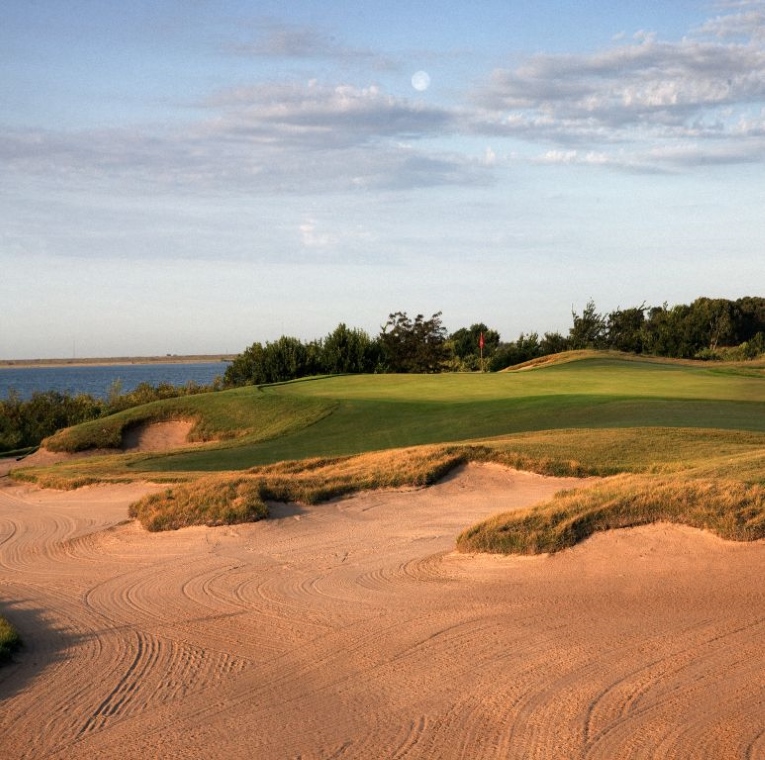
The style of Old American was inspired by some of Justin Leonard’s and Tripp’s favorite early American courses. Above is the 12th with Lake Lewisville in the background.
We have some really large greens, while we have some very small greens. We have some greens without much slope and some with a good bit. The overall stylistic theme is a bit rugged, and we generally took ideas from courses that had that overall style and feel – less from parkland like courses. But, we tried to make the overall feel of the course to be highly strategic. It is a course we tried to get players to talk less about style and more about how they had to think their way around it.
12. Both are located on a Lake Lewisville, so I assume the two sites are equally windy? What kind of grasses did you go with to allow the ball to scoot?
It can be very windy on Lake Lewisville. Both courses are Bermuda tee to green (after converting the Tribute to Bermuda last year), and as long as Bermuda is dry it is pretty bouncy. We were not on sand, so the key was to make sure both courses drained really well so it stays as dry as possible and both courses understand the purpose in keeping the courses dry. While most of the courses we were allowing to inspire the design are on sand, they do tend to have a lot of slope and roll, which contributes to good surface drainage, and because we were not on sand, we directed slope to drain basins to get them to drain well.
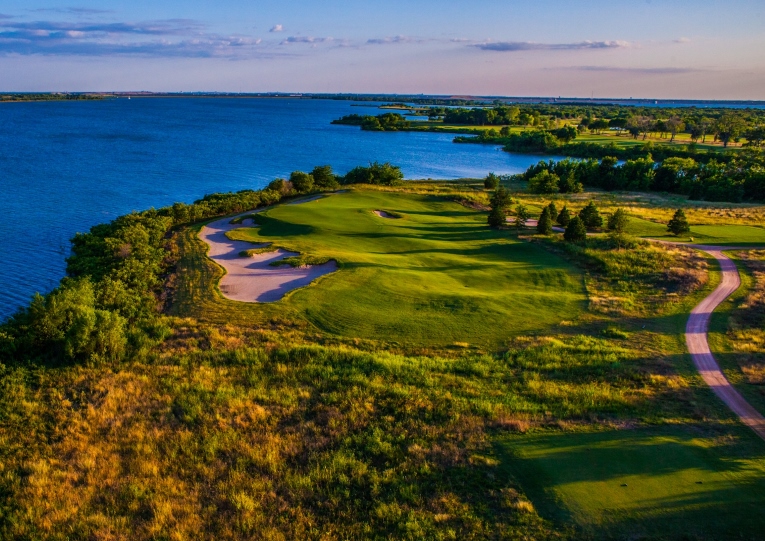
Big water views greatly enhance the playing experience on Long Island at a couple of Tripp and Justin’s favorite courses, namely Maidstone and NGLA. Similarly, Lake Lewisville – and the wind off it – plays a central role in adding to enjoyment of a round at Old American.
13. What’s an example of a world-renowned hole that you think is overrated?
That is a tough question because they are on courses I would like to be welcomed to play again. I also tend to look for the good and interesting features in a hole. But, there is one feature I find to be overrated or not as interesting as some think it is, and that is the mass hazard that crosses a hole that does not provide any option to play around it, and that hazard is a considerable carry. This is my opinion, mainly because I like options and strategic variety over purely penal design. I am sure you have played some holes I am thinking of.
14. Can a course be interesting to play if its fairways are narrow (less than 30 yards wide)?
There is no question in my mind that width in fairways and playing corridors adds interest by generally providing more options. I think a course that is almost completely void of width is more about executing and less about having to make up your mind about how you will play a hole, see and feel shots that fit that strategy, commit, and then execute that shot. When options produce thought and challenge commitment, executing is more interesting and it can be more challenging. However, I do think there are times in a round where a tight hole can fit, add variety, and help to test a player in a different way.
15. You have worked at Whippoorwill since 2001 and I am a HUGE fan of that course and your work. Where do you place Banks’s work with those of the best around New York City? What do you admire the most about it?
Banks’s work as a whole at places like Whippoorwill, Tamarack, Forsgate, and Knollwood, add to the variety of what you find in the Met area for sure. There are so many good courses in the Met area, but I think Whippoorwill holds its head high. As with the way Raynor fit in his template holes into the existing landscape, what Banks did on a fairly radical landscape at Whippoorwill was an engineering feat to begin with, and to have that result in a course that is very challenging, yet really fun for a lot of player types to play, was amazing. There are obviously built elements on any course that Raynor or Banks did, but when you study Whippoorwill, it is extraordinary how well everything fits the land, and how the land was used to create great variety both visually and the shots required to play the course well. I wish he had lived longer to do more work.
16. Please site a specific example of a hole whose transformation really pleased you at The Whip.
I think there were a good many holes where tree removal, restoration of lost bunkers, restoring existing bunkers, and green expansions really changed what the players see and play, but the 17th, the “Eden” par three, is probably the most transformed. It started with restoring little bunkers up the right, to then get the front left bunker back to its original shape and depth, expanding the green to the corners and to the edges to make the hole locations more interesting near the edges, and maybe most profoundly was tree removal along the right and at the back of the green. While there are still some trees along the road on the other side of the 10th hole in the background, when you are on the tee you don’t get the feel of those trees being right at the back of the green. I wish we could remove those trees along the road in the background, but they are off property. It is a hole you really need to see in person – one of my favorite holes in the world.
17. Let’s talk about Grand Elk Lodge & Club. Sounds like the land held little promise until you came up with the idea to go with what’s been called a heathland look?
The indigenous plant material gives it that look, and we tried hard to keep as much of that as we could and integrate it into the play of the holes. It is in a valley for the most part, but it does have some roll, so we were able to use terrain that is similar to some of the heathland courses I have seen around London. But, there were other site issues we had to work with and around, such as wetlands, an irrigation “creek”, and we had to build a lake for irrigation water storage. It is also almost completely void of trees, so while it has some characteristics of a heathland site, it is really more of a Colorado high sierra landscape. I think there is a lot you can take from the landscapes you have seen on the great courses of the world, but ultimately, you have to work the landscape where you are. At Grand Elk, because there are no trees, it was being tagged as a “links” course, but I suggested that it was more like a heathland course, which someone that was marketing the course overheard, and it stuck.
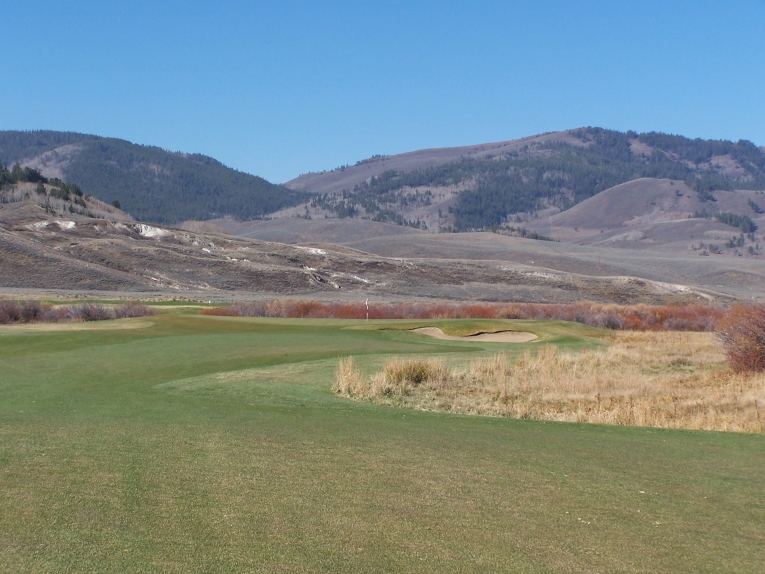
The rust hue of the high desert prairie scrub evokes thoughts of a heathland; the distant mountains do not!
18. So tell us this: what is the most exotic location where you have worked? Was it sand based?
In some ways the course we did in China was “exotic”, but it was not as fun as the new course we did in Acapulco at the Fairmont Princess. The resort was developed by JP Getty in the 1950’s, I think. There were two courses there when we got involved – one by RTJ Sr. and Ted Robinson. They asked us to take the land for the Pierre Marques course (the RTJ Sr. course), along with a little bit of additional land, to build a new course with room for a new entry road and a few more resort housing units. The new courses is called Turtle Dunes. The property is on the Diamante Peninsula southeast of downtown Acapulco out toward the airport.
While most of Acapulco is quite hilly, the peninsula was formed by sand and is pretty flat. We did a little research and found that a 100 plus years ago the site was just sand dunes and it was a place sea turtles would come inland and lay eggs. The site for the new course is about 150 meters from the beach, but we treated it like restoring sand dunes in the way they would have formed coming off the Pacific Ocean through wind and water action – rolling inland in “waves”. That was how we looked at the grading for the property before we did any routing and it really made the course feel like a very authentic part of the landscape. There were also some huge Parota Trees that we worked around. It was very good sand, though some places had a little bit of soil in it. We dug around the site to find the sand with some soil and we mined that to test it for greens. We built up 500 ton piles and tested each. What was good for greens we used for greens and what was not we mostly used for bunkers. Because it was so flat, with a pretty high water table, we had to build lakes to collect water and mine sand to raise some of the lower parts of golf holes.
Jason Gold, my Shaper, and I just had a blast working there. It did not hurt that we had a Fairmont to stay in and the other course there, the Princess Course Ted Robinson did, was open so we could play after or before work a good bit. Even in the summer we could tee off really early and it was a nice temp and humidity. I think it is some of our best work and I wish it was easier to get to and it was still a place Americans spent a lot of time in.

One of Tripp’s most fun projects was in Acapulco where he completely remodeled one of the Fairmount Hotel’s courses.
19. Where do you stand with your work at Spring Lake in New Jersey? Talk about a course with design pedigree!
We did a Master Plan a few years back and we have since done all of the bunker work, most of the tees, we have expanded some of the greens back to their original size, and done most of the tree work – removal mostly. I think Superintendent Josh Reiger has removed close to 250 trees now. We still want to rebuild the 9th green, which was changed many years ago into an unusual green. We want to rework the 18th so we recapture the ability to use some of the original hole locations, and we have a few greens I would still like to expand. George Thomas did the original routing and design in 1910 and Tillinghast came in and while he pretty much kept the routing, he rebuilt the greens, bunkers and moved some fairways a bit. The bunkers Tillinghast did were clearly grass faced, and for the most part we kept that basic style, but we also decided that moving the sand lines a little bit with some irregular movement would be a cool nod to Thomas. We also implemented some larger sandy areas that are pretty much bunkers, being a nod to large sandy areas in places around the course, which Tillinghast had somewhat turned into bunkers in places. It is a great club and they do a great job taking care of the golf course.
20. What are your thoughts on green speeds when you are restoring a course with Tillinghast greens, for example? Tillie never would have dreamt of today’s speeds but to mute his contours seems like a real shame. Where is the balance?
That is a very relevant question because we just reworked Oak Hills in San Antonio, where the greens had largely been “flattened” in the early 1980’s, which was not atypical at that time as architects and superintendents were concerned with where green speeds where headed. A lot of the greens at Oak Hills are what I would call lay of the land in that the fairway often led right into the green without much change in elevation. In what I have seen of Tillinghast, this approach was meant to encourage players to run shots into the greens, which is very much the case at Spring Lake in New Jersey, and with such greens I often found that Tillinghast would have less severity from back to front or side to side, and more “ripples” in the greens, with some steps, to both challenge distance control, and what I noted above as being able to match line and speed with some subtle movement. I have found that these type of greens would have what I call “winged backs” which I first noticed on some of the greens at Winged Foot playing in the Anderson Memorial there – particularly the 4th green on the West, where the winged backs there were rough when I first started playing there. This style of green is more conducive to adapting to faster greens speeds than a green with mostly severe back to front slope, like the 15th on Winged Foot West. Still, when you go from pretty flat, to more ripples and movement, some players can not really embrace what you have done. It then becomes a matter of relearning the greens and realizing that a good shot is simply not one you hit solid and got it within 30 feet of the cup – it has to be on the proper side of the hole to truly be a good shot, which with this type of green may not always mean being below the hole.
I think the balance is less about muting the slopes overall, but more about making sure there are a good many hole locations on reasonable slopes for modern speeds (I like to use less than 3%), and making sure where you put those hole locations are not impossible to get to with approach shots, putts or shots around the green, relative to the unmuted slopes you keep or restore. You can’t design such greens in a bubble – thinking more about the green than the overall play of the hole. About 8 months after reopening Oak Hills, the members are beginning to realize that what we did is a lot more interesting and more fun to play, and simply requires more thought.
21. What work did you do to Oak Tree National to prepare it for the 2014 U.S. Senior Open? How had this Pete Dye design changed since its inception?
Oak Tree National has a good many tour pros who call it home, and to some extent they were involved, especially Scott Verplank who won the 1984 U.S. Amateur there. Jason Gold, my Shaper, was busy at Preston Trail in Dallas, so Bill “Hollywood” Willingham did the work, having done some work on Pete Dye courses prior. The main goal was to renovate/restore the bunkering, rebuild tees, re-grass the course, install a new irrigation system and rework a few interior contours in greens without completely rebuilding them, although we pretty much ended up rebuilding a few to get them more like they were in 1984.
I first played the course in the fall of 1985 as a freshman on the University of Oklahoma golf team, so I remembered a lot of it as well. The main difference was the loss of some bunkers we put back, there were a lot of native grasses along most holes, which we put back in part, and trees had grown to crowd some holes, where we either trimmed them back or cut them out. Some tees had been pushed back since 1984 or 1985, but it was not too dramatic and most did fit the way the course played today. The work to the greens was to get some of the bite back, but also to get some of the angles back.
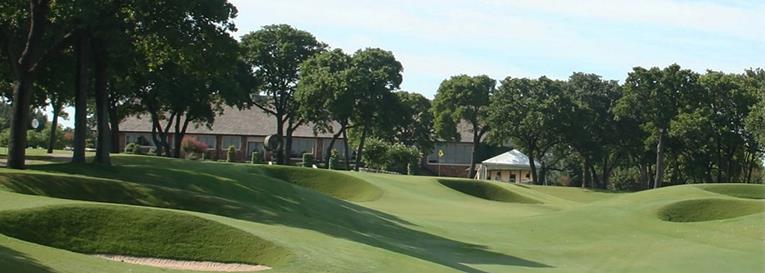
The above picture of 18 at Oak Tree captures how prominent the bunkering is and how it helps to see lines and form strategy.
22. I have never been. Can a 10 handicap golfer have fun playing that course at ~6,400 yards or are the green surrounds too penal?
Oak Tree National was built for championship play, but as I find with most Pete Dye courses, there are options to play it without always having to hit it perfect, and even those really tough shots are very heroic and fun to play. It is built for match play more than stroke play in my opinion and that is primarily the way the guys there play it, so score is less of an issue. It is tough, but there are older members that would kill us if we made it easier. A 10 handicap can have fun, but they have to go there not worried about score, but playing the fun shots Pete designed.
23. What trend do you like right now in golf design? What trend do you think needs to fade away?
I am not much of a trend architect, preferring design that is not necessarily always “classic”, but always contributes to making the game fun to play in a way that will last. I think most every type of design that does that has been done, and was being done in places for many years. That being said, some of those traits went away and some are coming back. Where it fits, I like fairway cuts around greens in a similar way to what you find on some of the links courses or at Sand Hills. It does not always fit though, and I find that Tillinghast did not really design greens complexes to have this work. While I like the square tees we see being somewhat a sign of a “classic” design, I think it has been a little over done in places, while I think doing more rounded like tees can be a better fit, especially on sites where the tees are located on slopes. The lacy edge bunkers that many would consider are in vogue now are not new either, and I think they fit in places, while not fitting in others. Same with wider fairways, where that was mostly the case on the early links courses, but it was lost in our country for a time, which in my mind fits more often than not. One thing that is somewhat new, as best I can tell, is much shorter forward tees. A lot of the clubs we work with could not be played shorter than 5,600 yards, when there are a lot of players, mostly ladies, that really benefit from a course being shorter. It is often a fight to get that done though.
I guess you could make an argument that a “trend” is building courses where strategic interest is the make up more than penal design, which is also an old trait that in some ways was lost, which is a trend I embrace. If there is a “trend” I would like to see fade away is the thought that in order to best challenge the best players we have to simply build something long and hard. Creating a complete examination of the game where every player in the field has the opportunity to strategically compete does not require simply long and hard – in fact I am quite sure long and hard limits those in the field that can compete. And, if you create a complete, and “balanced”, examination, keeping scores near par is not a necessity because whatever the winning score is you will have identified the best player in the entire field.
The End


